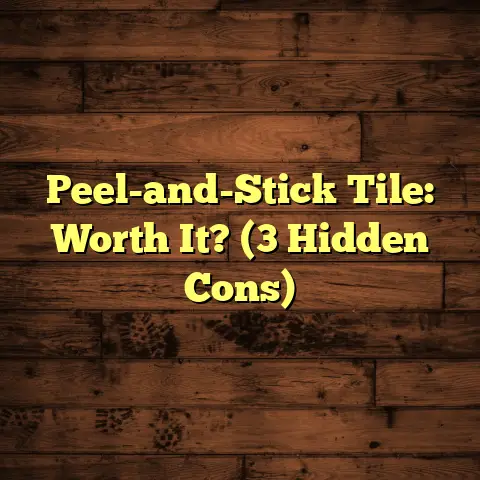How To Put A Shine On Hardwood Floors? (Explained)
Imagine walking into a room, and the first thing that catches your eye is the stunning shine of the hardwood floors. It creates a welcoming atmosphere and reflects the care that you put into maintaining your space. Many people ask me how to achieve that gleaming finish on their hardwood floors, and I’m excited to share some insights from my experience.
Understanding Hardwood Floor Finish
Before diving into how to achieve a brilliant shine on hardwood floors, let’s clarify what a finish is. The finish protects the wood from damage and enhances its appearance. Common finishes include polyurethane, varnish, and oil-based treatments. Depending on the type of finish used, the approach to shining the floor may vary.
Types of Hardwood Floor Finishes
- Polyurethane Finish:
- Description: This is one of the most common finishes used for hardwood floors. It is available in both water-based and oil-based formulas.
- Advantages: Highly durable, resistant to scratches and stains, and easy to clean.
- Disadvantages: Can take longer to cure, and oil-based versions may yellow over time.
- Varnish Finish:
- Description: Varnish provides a hard protective layer and is available in various sheens.
- Advantages: Enhances the natural beauty of the wood and provides good protection.
- Disadvantages: Requires multiple coats and can be difficult to apply evenly.
- Oil-Based Finish:
- Description: Penetrates deep into the wood, providing a rich color and luster.
- Advantages: Enhances grain visibility and offers good protection.
- Disadvantages: Longer drying times and may require more maintenance.
- Water-Based Finish:
- Description: Dries quickly and is low in volatile organic compounds (VOCs).
- Advantages: Fast-drying and less odor during application.
- Disadvantages: May not be as durable as oil-based finishes.
- Wax Finish:
- Description: Provides a natural look with a soft sheen.
- Advantages: Easy to apply and reapply; can be buffed for additional shine.
- Disadvantages: Requires regular maintenance and can be difficult to strip off completely.
Preparation: The First Step
The first step in putting a shine on hardwood floors is always preparation. I learned this early in my career. I once rushed into polishing a client’s floors without thoroughly cleaning them, leading to a less-than-stellar result. Dust and dirt will only dull your efforts, so here’s how I prepare:
Steps for Preparation
- Clear the Area:
- Remove all furniture and rugs from the floor. This not only makes it easier to clean but also prevents any scratches or damage during the polishing process.
- Dusting:
- I use a microfiber mop or cloth to gather dust and debris effectively. This prevents scratches during the polishing process. Microfiber is ideal because it attracts dust rather than just pushing it around.
- Deep Cleaning:
- For deeper cleaning, I mix a solution of water and a few drops of pH-neutral cleaner to damp mop the floor. I ensure that I wring out the mop well, as excess water can damage hardwood.
- After mopping, I allow the floor to dry completely before proceeding with any polishing or application of products.
- Inspect for Damage:
- After cleaning, I take the time to inspect the floor for any scratches or damage that may require attention before shining. Addressing these issues early on can prevent further complications down the line.
Choosing the Right Product
There are countless products available for shining hardwood floors, and I’ve tried many of them. Here’s a breakdown of what I’ve found works best:
Options for Hardwood Floor Shine
- Liquid Polish:
- This is a popular choice for quick touch-ups. It can provide a nice shine but requires regular application.
- Pros: Quick and easy application; provides instant shine.
- Cons: May need frequent reapplication; can create buildup over time.
- Wax:
- Wax can create a beautiful finish but requires more elbow grease to apply and maintain. I found that stripping wax can be quite labor-intensive.
- Pros: Natural finish; can be buffed for added shine.
- Cons: Requires regular maintenance; buildup can dull appearance.
- Shine Restorer:
- These products are specifically designed to restore the shine without heavy waxing or stripping. They’re user-friendly and effective.
- Pros: Easy to use; provides good results with minimal effort.
- Cons: Not all restorers are created equal; some may not provide long-lasting results.
In my experience, I prefer using a shine restorer because it’s less time-consuming and yields great results without the buildup associated with wax.
Application Techniques
When it comes to applying the chosen product, how I do it can make all the difference:
Steps for Product Application
- Stir Before Use:
- Always stir the product well to ensure an even application. Some products may settle over time, so this step is crucial.
- Use a Soft Applicator:
- I use a clean mop or cloth specifically designed for applying floor polish to avoid scratches. A soft applicator ensures that I don’t inadvertently mar the surface while applying the product.
- Apply Evenly:
- I work in small sections, applying the product evenly and avoiding puddles. This ensures that every area gets equal attention.
- Following the manufacturer’s instructions regarding application techniques is essential for achieving optimal results.
- Buffing:
- After allowing the product to dry as directed, I often buff the surface with a clean microfibre cloth or a buffing pad attached to a floor machine for added shine.
Maintenance for Longevity
To keep that shine looking fresh, regular maintenance is crucial. Here’s what I recommend based on my experience:
Routine Maintenance Tips
- Routine Cleaning:
- Sweep or vacuum regularly to prevent dirt accumulation. Using a vacuum with a soft brush attachment helps protect the floor from scratches.
- Damp Mopping:
- Use a damp mop weekly with a suitable cleaner to maintain shine. Avoid excessive water exposure as it can seep into seams and damage the flooring.
- Avoid Harsh Chemicals:
- Strong chemicals can strip the finish and dull the shine over time. Always opt for pH-neutral cleaners specifically designed for hardwood floors.
- Regular Inspections:
- Every few months, I recommend inspecting floors for any signs of wear or damage so they can be addressed promptly.
Cost Estimation with FloorTally
When planning these projects, understanding costs is essential. I often use FloorTally for accurate estimations. It pulls local material and labor rates, which helps me provide clients with realistic budgets right from the start. For example, when I recently worked on a project for a 1,200 square foot home, FloorTally allowed me to estimate costs for materials like polish and cleaners precisely, making budgeting straightforward.
Budgeting with FloorTally
- Material Costs:
- By inputting various materials (like cleaning solutions or polish), FloorTally provides estimates based on current local prices, which is invaluable when discussing budget constraints with clients.
- Labor Costs:
- Labor costs can vary significantly depending on location and project complexity. FloorTally helps me factor in these variables accurately so clients know what to expect financially.
- Hidden Costs:
- Flooring projects can include hidden costs, like removing old flooring or preparing surfaces. With FloorTally, I can account for all expenses upfront, ensuring my clients are fully aware of total project costs before we begin.
Successes and Challenges
Throughout my career, I’ve had both successes and challenges while trying to achieve that perfect shine. One memorable project involved an older home with deep scratches on the hardwood floors. After sanding down the surface and applying a new finish, the floors transformed beautifully. However, I encountered challenges when using wax; it required multiple applications to achieve the desired look, which took up more time than anticipated.
Case Study: Transforming an Old Home’s Floors
- Initial Assessment:
- When I first assessed an older home built in the 1950s, I noticed extensive wear marks throughout the living room due to years of neglect. The owners desired a shiny finish that would breathe new life into their space.
- Preparation Process:
- The first step was carefully sanding down the existing finish to remove scratches and imperfections. This process took about three days because we wanted to ensure we did not damage the wood beneath.
- Finishing Touches:
- After sanding, we decided on a water-based polyurethane finish for its durability and quick drying properties. Applying two coats took another two days (including drying time), but we achieved stunning results that left the homeowners thrilled.
Comparing Different Approaches
Over time, I’ve tried various methods of achieving shine on hardwood floors, each with its advantages and disadvantages:
- Wax vs. Synthetic Polish:
- Wax provides an authentic look but requires more maintenance compared to synthetic polishes that offer instant shine with less effort.
- DIY Solutions vs. Commercial Products:
- Some homeowners prefer DIY solutions like vinegar and water mixtures; however, I’ve found that commercial products often yield better results without risk of damaging finishes over time.
- Professional Services vs. DIY Maintenance:
- Hiring professionals ensures quality results but comes at a higher cost compared to DIY maintenance routines, which require more time commitment from homeowners but less financial investment.
Advanced Techniques for Achieving Shine
For those who want even more vibrancy in their wood floors, there are advanced techniques you might consider:
Buffing Machines
Using a professional-grade buffing machine can drastically improve your results if you’re handling larger areas or want consistent sheen across your floors.
- Selecting Equipment:
- When choosing a buffing machine, consider factors such as size (for ease of handling) and power (for consistent results).
- Technique:
- Work in circular motions while keeping steady pressure; this helps avoid streaks while enhancing overall shine.
Professional Refinishing
For floors that have lost their luster due to significant wear or damage:
- Sanding Down:
- A professional refinisher will sand down to bare wood if necessary before applying new finishes—this process revives even heavily worn floors.
- Custom Finishing Options:
- Consider custom stain options when refinishing—different stains can dramatically change aesthetics while protecting wood underneath.
Conclusion
Achieving a stunning shine on hardwood floors isn’t just about applying polish; it’s about understanding your materials, preparing correctly, and maintaining your floors regularly. Whether you’re using liquid polish or opting for a shine restorer, each approach has its merits.
By investing time in proper maintenance and utilizing tools like FloorTally for cost estimation, you can keep your hardwood floors looking their best for years to come.
In summary:
- Proper preparation is essential.
- Choose high-quality products suited for your specific floor type.
- Regular maintenance will prolong shine.
- Utilize estimating tools like FloorTally for accurate budgeting in projects.
- Don’t hesitate to seek professional help when necessary—some projects are best left to experts for optimal results.
With careful planning and execution, your hardwood floors can shine like new, enhancing your home’s beauty and value while reflecting your commitment to quality care.





